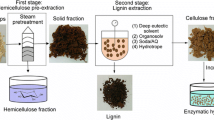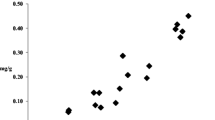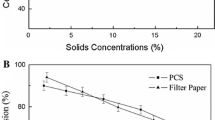Abstract
Steam-heating of aspen wood chips improved the enzymatic digestibility of the cellulose. Scaling up the reaction vessel from 2 to 60 L had virtually no influence on the chemical composition and the accessibility of the lignocellulosic substrate. Over 85% of the cellulose could be hydrolyzed to glucose when an 8% substrate concentration was used. The residual content of alkali-insoluble lignin appeared to control the digestibility of the cellulose. Increased delignification either by prolonged steaming, oxidative posttreatment, or SO2 catalysis improved the accessibility of the cellulose. The use of SO2 as a catalyst also increased the recovery yield of the wood after steam-heating, with more than 70% of the original xylan recovered as monomeric xylose. Conversion yields of above 90% were achieved at low levels of filter paper activity after a relatively short incubation time. Removal of alkali-soluble lignin did not influence digestibility when the enzyme concentration was based on the cellulose content of the substrates.
Similar content being viewed by others
Abbreviations
- SHA-WI:
-
water-insoluble fraction of steam-heated aspen wood
- SHA-WIA:
-
water-and-alkali-insoluble fraction of steam-heated aspen wood
- SHA-WIA/H2O2:
-
water-and-alkali-insoluble fraction of steam-heated aspenwood posttreated with hydrogen peroxide
References
Sudo, K., Shimizu, K., Ishii, T., Fujii, T., and Nagasawa, S. (1986),Holzforschung 40, 339.
Dekker, R. F. H., Karageorge, H., and Wallis, A. F. A. (1987),Biocatalysis 1,47.
Biermann, C. J., Schultz, T. P., and McGinnis, G. D. (1984),J. Wood Chem. Technol. 4(1), 111.
Lynd, L. R. and Grethlein, H. E. (1987),Biotechnol. Bioeng. 29, 92.
Lee, Y.-H., Robinson, C. W., and Moo-Young, M. (1987),Biotechnol. Bioeng. 29, 572.
Hoermeyer, H. F., Bonn, G., Kim, D. W., and Bobleter, O. (1987),J. Wood Chem. Technol. 7(2), 269.
Saddler, J. N. and Brownell, H. H. (1982),Proc. Royal Soc. Canada, Int. Symp. on Ethanol from Biomass, Duckworth, H. E., ed., Winnipeg, Canada, p. 206.
Schwald, W., Chan, M., Brownell, H. H., and Saddler, J. N. (1988),Proc. FEMS Symp. No. 43, Biochemistry and Genetics of Cellulose Degradation, Aubert, J. P., Béguin, P., and Millet, J., eds., Academic, London, p. 303.
Saddler, J. N. (1986),Microb. Sci. 3(3), 84.
Klesov, A. A. and Sinitsyn, A. P. (1981),Bioorganicheskaya Khimiya 7(12), 1801.
Cowling, E. B. and Kirk, T. K. (1976),Biotechnol. Bioeng. Symp., No. 6, 95.
Schurz, J. (1986),Holzforschung,40, 225.
Rivers, D. B. and Emert, G. H. (1988),Biotechnol. Bioeng. 31, 278.
Fan, L. T., Lee, Y.-H., and Beardmore, D. H. (1981),Biotechnol. Bioeng. 23, 419.
Grethlein, H. G. (1985),Bio/Technol. 3, 155.
Clark, T. A. and Mackie, K. L. (1987),J. Wood Chem. Technol. 7(3), 373.
Wong, K. K. Y., Deverell, K. F., Mackie, K. L., Clark, T. A., and Donaldson, L. A. (1988),Biotechnol. Bioeng. 31, 447.
Brownell, H. H. and Saddler, J. N. (1987),Biotechnol. Bioeng. 29, 228.
Gould, J. M. (1984),Biotechnol. Bioeng. 26, 46.
Irick, T., West, K., Brownell, H. H., Schwald, W., and Saddler, J. N. (1988),Appl. Biochem. Biotechnol. 17, 137.
Schwald, W. and Saddler, J. N. (1988),Enzyme Microb. Technol. 10 37.
Schwald, W., Chan, M., Breuil, C, and Saddler, J. N. (1988),Appl. Microbiol. Biotechnol. 28, 398.
Brownell, H. H., Yu, E. K. C., and Saddler, J. N. (1986),Biotechnol. Bioeng. 28, 792.
Chum, H. L., Johnson, D. K., Black, S., Baker, J., Grohmann, K., Sarkanen, K. V., Wallace, K., and Schroeder, H. A. (1988),Biotechnol. Bioeng. 31, 643.
Nguyen, Q., Douglas, L. J., Schuler, A. T., and Saddler, J. N. submitted for publication.
Mackie, K. L., Brownell, H. H., West, K. L., and Saddler, J. N. (1985),J. Wood Chem. Technol. 5(3), 405.
Author information
Authors and Affiliations
Rights and permissions
About this article
Cite this article
Schwald, W., Breuil, C., Brownell, H.H. et al. Assessment of pretreatment conditions to obtain fast complete hydrolysis on high substrate concentrations. Appl Biochem Biotechnol 20, 29–44 (1989). https://doi.org/10.1007/BF02936471
Issue Date:
DOI: https://doi.org/10.1007/BF02936471




